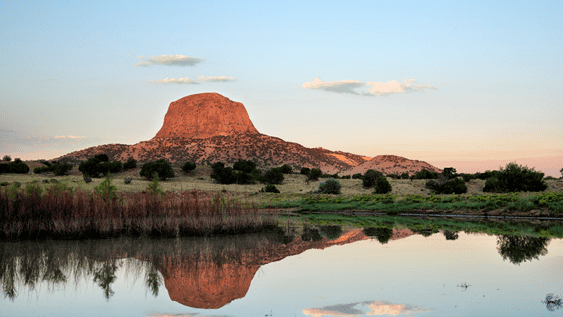Cabezon Peak after rain, Photo by John Fowler (CC BY 2.0)
Although climate change is a global issue, it can and must be addressed locally. Our overall climate is shifting drastically, but local climates are also changing, and they don’t always get the same amount of attention. Local climates change when the environment is drastically altered. This happens when the soils are depleted or covered with pavement, or when local water sources are drained and exported to rivers and eventually oceans. To restore local climates, we can start by restoring local natural cycles, and the first cycle we can look to is water.
Not One Cycle, But Many
You might have heard of ‘the water cycle,’ but there are actually many water cycles. They are in action at all times. Long water cycles draw their moisture primarily from the ocean, while short water cycles – also known as small water cycles – recirculate moisture on land. These cycles release water into the atmosphere through plant water vapor. Once the water reaches the skies, it forms clouds, and the cycle continues as clouds return the water to the land via rain. Evapotranspiration and precipitation are two processes in water cycles that ensure water stays in the respective region long-term.
Without water and its many cycles, our Earth would be hot, far too hot for us to live. The energy from the sun has to go somewhere. It is, after all, aimed directly at the planet. When plants and water are involved, the sun’s energy goes into plants to create life. Without plants or water, that energy gets absorbed by the land and creates ground too hot to walk on, let alone live on. The presence of water and the cycling of it controls local climates. It also provides moisture to plants and forms the clouds that moderate the Earth’s temperatures. The saying “water is life” could not be more accurate.
Where Did the Water Go?
If you live in a region with constant drought, you might be wondering what happened to the local water cycles, as precipitation has become more infrequent and unpredictable. Unfortunately, this scenario is becoming more and more common. As we continue to develop, paving over soils that absorb water with concrete and asphalt, we are increasing the surface area of impenetrable surfaces. Depleted soils also don’t absorb water, and when water doesn’t go underground, water cycles get disrupted – making it more difficult for all living beings to survive. The water that fails to be absorbed runs off the land (hence, the term runoff) and flows into storm drainages. Rather than keeping water local, we’re sending fresh, life-giving water to faraway rivers and oceans. For water to contribute to the local climate, it must stay in the area, meaning we need permeable ground and healthy soil.
Poor land and water management has led to an alarming loss of topsoil and decline in soil health. Industrial farming systems rely on chemicals and heavy machinery detrimental to life in the soil. Yet we need those microorganisms in the soil to build good aggregation (pore spaces) and symbiotic relationships with plants that form the basis of a functioning small water cycle. When we disrupt local water cycles and water runs off rather than evenly spreading over the land and infiltrating, we create conditions that lead to droughts, floods, heat waves, intense storms, and sea level rise.
Graphic by NM Healthy Soil Working Group
How can we restore local water cycles?
The good news is that we can restore the small water cycle by re-building the porous structure of the soil sponge – a term coined by Australian soil microbiologist Walter Jehne. Following nature’s strategy and applying the soil health principles, combined with slowing and capturing rainfall through earthworks (e.g. swales and small check dams), allows the soil to regenerate. Water gets absorbed instead of running off, some of it providing moisture for plants near the surface, and some percolating deeper underground to recharge aquifers that create water sources for all living beings.
How plants create rain: Somewhat akin to us breathing in and out, plants move water from the roots through trunks, branches, and stems, and ultimately out via the stomata (tiny pores) in leaves. Through this process, plants move nutrients to where they are needed –either nutrients from the soil or the sugars and carbohydrates photosynthesized by leaves. The water transpired by the plants becomes a key source for the formation of clouds and rain.
Therefore, to create rain in arid environments, we need more plants. Keeping all possible surfaces covered with living plants and reducing paved areas and bare ground will go a long way to restoring the small water cycle and, in return, restoring life itself. It will also maintain cooler surface temperatures and reduce the reradiation of long wave infrared heat from the Earth’s surface, which is the primary factor that drives the natural, and now exaggerated, greenhouse effect. As Walter Jehne says: “On a larger scale these same processes all play their role in helping to regulate the global climate through both the carbon and water cycles. This means that as we work to restore our regional water cycles, we may well change the global climate.”
Graphic by Walter Jehne
Written by Tania Roa, Biodiversity for a Livable Climate and Isabelle Jenniches, NM Healthy Soil Working Group
Sources:
https://bio4climate.org/voices-of-water/
https://bio4climate.org/2019/04/30/evapotranspiration-a-driving-force-in-landscape-sustainability/
https://www.nmhealthysoil.org/2019/09/07/principles/ https://www.landandleadership.org/cool-moist-and-green.html





















